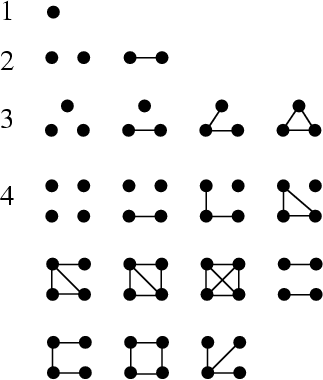|
|
|

A mathematical object composed of points known as Vertices or Nodes and lines
connecting some (possibly empty) Subset of them, known as Edges. The study of graphs is known
as Graph Theory. Graphs are 1-D Complexes, and there are always an Even number of Odd
Nodes in a graph. The number of nonisomorphic graphs with ![]() Nodes is given
by the Pólya Enumeration Theorem. The first few values for
Nodes is given
by the Pólya Enumeration Theorem. The first few values for ![]() , 2, ..., are 1, 2,
4, 11, 34, 156, 1044, ... (Sloane's A000088; see above figure).
, 2, ..., are 1, 2,
4, 11, 34, 156, 1044, ... (Sloane's A000088; see above figure).
Graph sums, differences, powers, and products can be defined, as can graph eigenvalues.
Before applying Pólya Enumeration Theorem, define the quantity
| (1) |
 |
(2) |
| (3) |
|
|
|
|
|
(4) |
|
|
|
|
|
(5) |
|
|
|
|
|
(6) |
| (7) |
| (8) | |||
| (9) | |||
| (10) | |||
| (11) | |||
| (12) | |||
| (13) |
Application of the Pólya Enumeration Theorem then gives the formula
|
|
|
|
|
|
|
|
(14) |
| (15) | |||
| (16) | |||
| (17) | |||
| (18) | |||
| (19) | |||
| (20) |
Letting ![]() then gives a Polynomial
then gives a Polynomial ![]() , which is a Generating Function for (i.e., the terms of
, which is a Generating Function for (i.e., the terms of
![]() give) the number of graphs with
give) the number of graphs with ![]() Edges. The total number of graphs having
Edges. The total number of graphs having ![]() edges is
edges is ![]() .
The first few
.
The first few ![]() are
are
| (21) | |||
| (22) | |||
| (23) | |||
| (24) | |||
| (25) | |||
| (26) |
|
|
|
|
|
(27) |
See also Bipartite Graph, Caterpillar Graph, Cayley Graph, Circulant Graph, Cocktail Party Graph, Comparability Graph, Complement Graph, Complete Graph, Cone Graph, Connected Graph, Coxeter Graph, Cubical Graph, de Bruijn Graph, Digraph, Directed Graph, Dodecahedral Graph, Euler Graph, Extremal Graph, Gear Graph, Graceful Graph, Graph Theory, Hanoi Graph, Harary Graph, Harmonious Graph, Hoffman-Singleton Graph, Icosahedral Graph, Interval Graph, Isomorphic Graphs, Labeled Graph, Ladder Graph, Lattice Graph, Matchstick Graph, Minor Graph, Moore Graph, Null Graph, Octahedral Graph, Path Graph, Petersen Graphs, Planar Graph, Random Graph, Regular Graph, Sequential Graph, Simple Graph, Star Graph, Subgraph, Supergraph, Superregular Graph, Sylvester Graph, Tetrahedral Graph, Thomassen Graph, Tournament, Triangular Graph, Turan Graph, Tutte's Graph, Universal Graph, Utility Graph, Web Graph, Wheel Graph
References
Bogomolny, A. ``Graph Puzzles.''
http://www.cut-the-knot.com/do_you_know/graphs2.html.
Fujii, J. N. Puzzles and Graphs. Washington, DC: National Council of Teachers, 1966.
Harary, F. ``The Number of Linear, Directed, Rooted, and Connected Graphs.'' Trans. Amer. Math. Soc. 78, 445-463, 1955.
Pappas, T. ``Networks.'' The Joy of Mathematics.
San Carlos, CA: Wide World Publ./Tetra, pp. 126-127, 1989.
Read, R. ``The Graph Theorists Who Count--and What They Count.'' In The Mathematical Gardner
(Ed. D. Klarner). Boston, MA: Prindle, Weber, and Schmidt, pp. 326-345, 1981.
Sloane, N. J. A. Sequence
A000088/M1253
in ``An On-Line Version of the Encyclopedia of Integer Sequences.''
http://www.research.att.com/~njas/sequences/eisonline.html and extended entry in
Sloane, N. J. A. and Plouffe, S.
The Encyclopedia of Integer Sequences. San Diego: Academic Press, 1995.
|
|
|
© 1996-9 Eric W. Weisstein